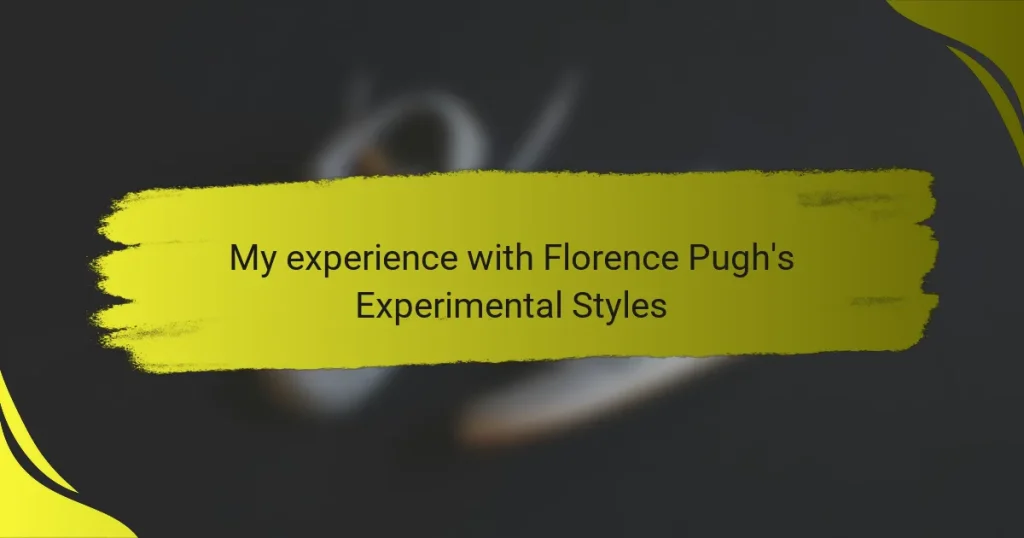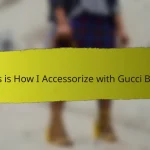Key takeaways
- Experimental fashion challenges traditional norms, focusing on both aesthetics and storytelling, encouraging deeper self-expression.
- Florence Pugh’s style evolution showcases personal reinvention through bold choices, inspiring others to conquer fears associated with self-expression.
- Incorporating experimental elements into your wardrobe can start small, emphasizing the importance of comfort and confidence in carrying bold looks.
- Fashion is a powerful narrative tool, encouraging individuals to see their clothing as reflections of personal stories and deeper emotions.
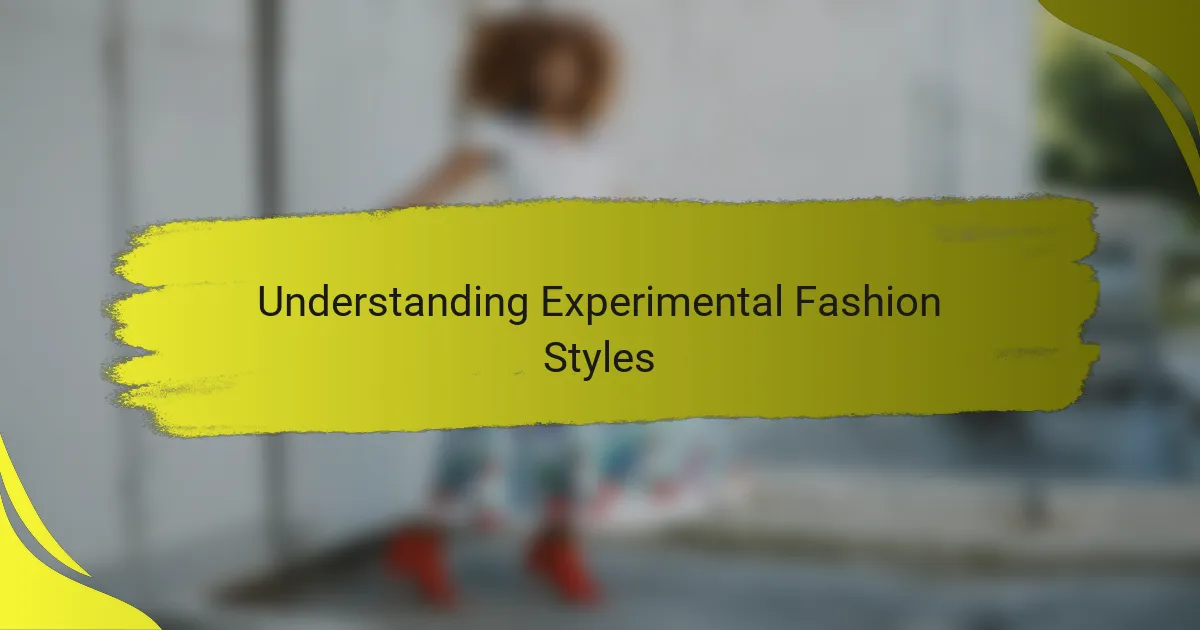
Understanding Experimental Fashion Styles
When I first encountered experimental fashion, I was struck by how it challenges the usual rules we take for granted. It’s like stepping into uncharted territory where designers play with shape, fabric, and even function in ways that seem almost rebellious. Have you ever seen something that felt so unconventional that it made you pause and reconsider what clothing can really be?
What fascinates me the most is that experimental styles don’t just focus on aesthetics; they often tell a story or explore deeper ideas. It’s as if the clothes themselves are communicating emotions or concepts that go beyond mere appearance. This pushes me to think about fashion not just as a form of self-expression but as a medium for creative exploration.
Sometimes, diving into experimental fashion can feel overwhelming because it defies easy categorization. But isn’t that part of its allure? It invites us to question norms and expand our definitions of beauty and style. From my experience, embracing this mindset opens new doors to appreciating fashion in a richer, more imaginative way.
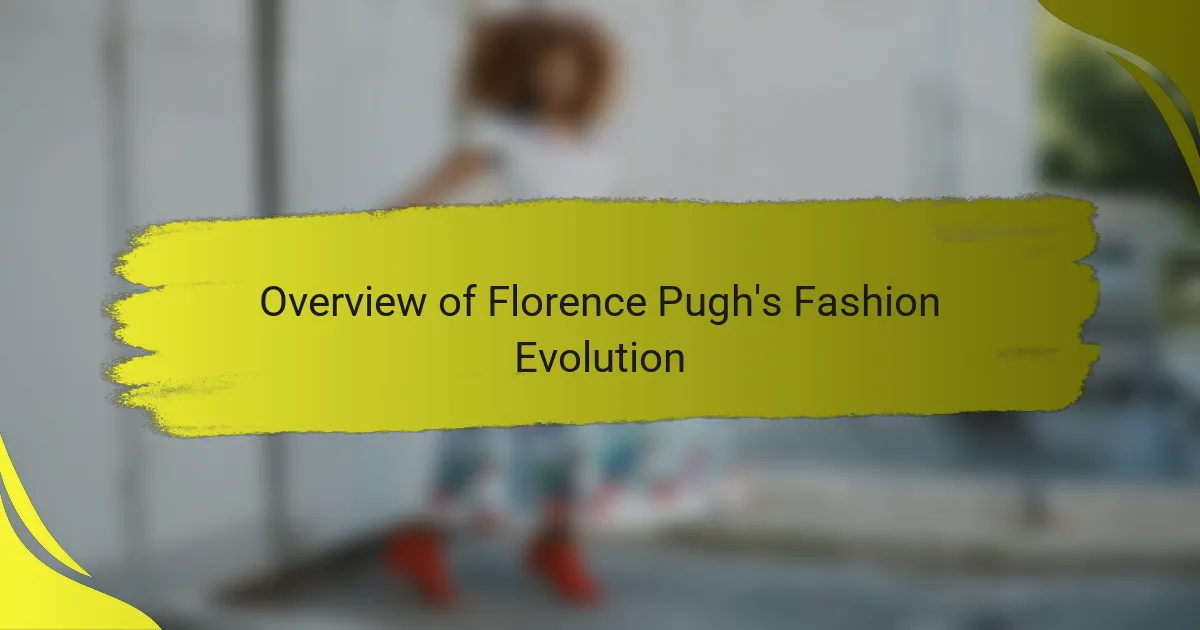
Overview of Florence Pugh’s Fashion Evolution
Florence Pugh’s fashion journey is a fascinating story of growth and bold choices. Watching her evolve from classic red-carpet elegance to daring, unconventional outfits made me realize how fashion can be a form of personal reinvention. Have you ever noticed how some celebrities seem to shed their old styles like a skin and step into something entirely new?
What struck me most is how she balances experimental designs with a sense of authenticity. It’s not just about wearing something eye-catching; it feels deeply personal, almost like each look reveals a new chapter of her identity. I remember feeling inspired seeing her take risks that many wouldn’t dare to, reminding me that fashion is about courage as much as creativity.
Her evolution also made me wonder—how often do we let fear of judgment hold us back from expressing ourselves fully? Florence’s fearless approach pushed me to reconsider my own boundaries with style. It’s as if she’s inviting us all to embrace change and surprise ourselves in the process.
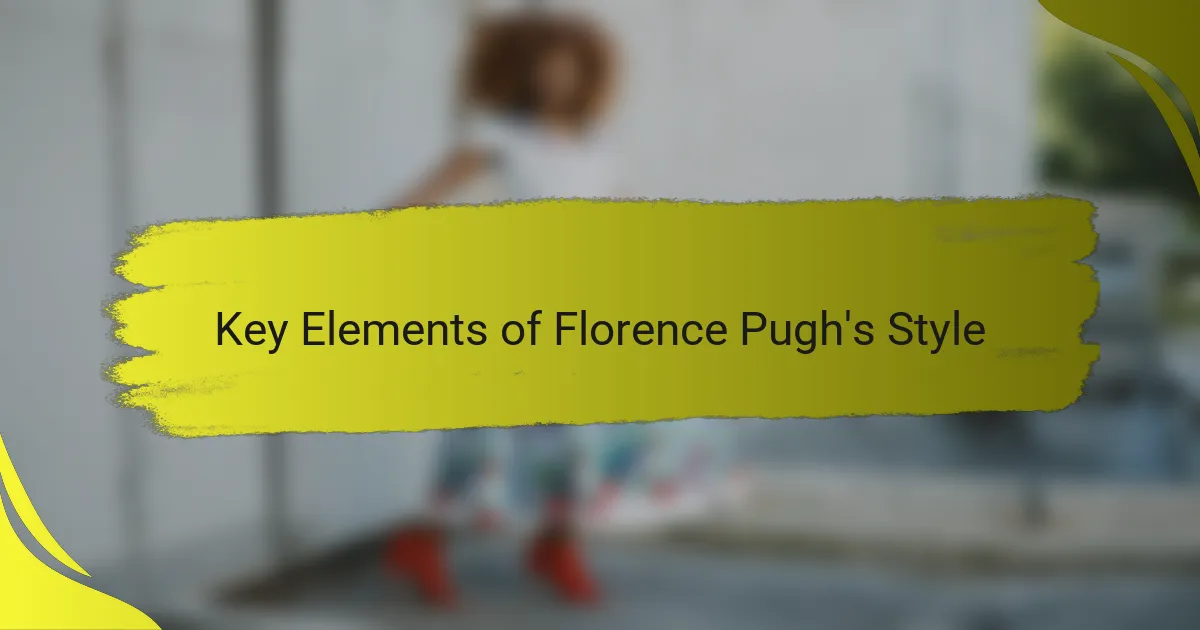
Key Elements of Florence Pugh’s Style
One thing that stands out to me about Florence Pugh’s style is her fearless mix of classic silhouettes with unexpected details. She might pair a traditional blazer with an asymmetrical hem or add a splash of bold color where you least expect it. This balance keeps her looks fresh but grounded, showing that experimental doesn’t mean chaotic—it can be thoughtfully striking.
I often catch myself admiring how she plays with textures, blending velvet, satin, and even metallic fabrics in ways that feel both playful and sophisticated. It’s like she’s inviting us to explore fashion’s tactile side, reminding me that style isn’t just about what we see but also what we feel. Have you ever tried wearing something just because it excited your senses rather than following trends?
Then there’s her knack for tailoring that hugs her frame perfectly, yet somehow feels relaxed, not stiff. To me, this speaks volumes about confidence; she knows she can bend fashion rules without losing comfort or identity. Watching her makes me question: are we giving enough attention to fit and comfort when chasing bold looks? Florence’s style teaches me that when those elements align, experimental fashion truly shines.
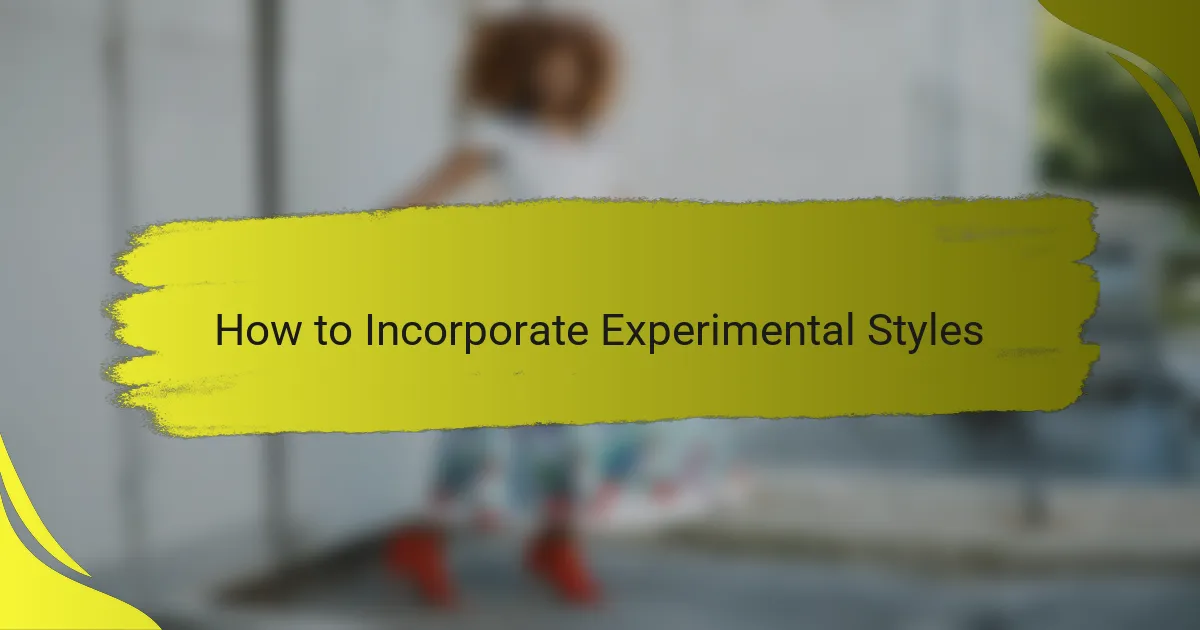
How to Incorporate Experimental Styles
Incorporating experimental styles into your wardrobe can feel like stepping into unfamiliar territory, but I’ve found that starting small makes all the difference. Maybe it’s adding one unexpected detail—a unique cut or a bold accessory—that nudges your comfort zone without overwhelming it. Have you ever tried pairing something unusual with a piece you already love? That mix often sparks the most interesting looks.
What’s been eye-opening for me is how experimenting with texture or proportion can completely transform an outfit’s vibe. For instance, swapping a classic fabric for something metallic or oversized can make a simple silhouette feel fresh and exciting. It’s about playing with contrasts and seeing how your personal style stretches and evolves in response.
Sometimes, the hardest part is silencing that inner critic telling you to “play it safe.” But I’ve learned that embracing risk is part of the thrill—and often leads to discovering new sides of myself. Do you notice how fashion becomes more fun when you stop worrying about perfection and just experiment for the sake of it? That freedom is contagious and, honestly, addictive.
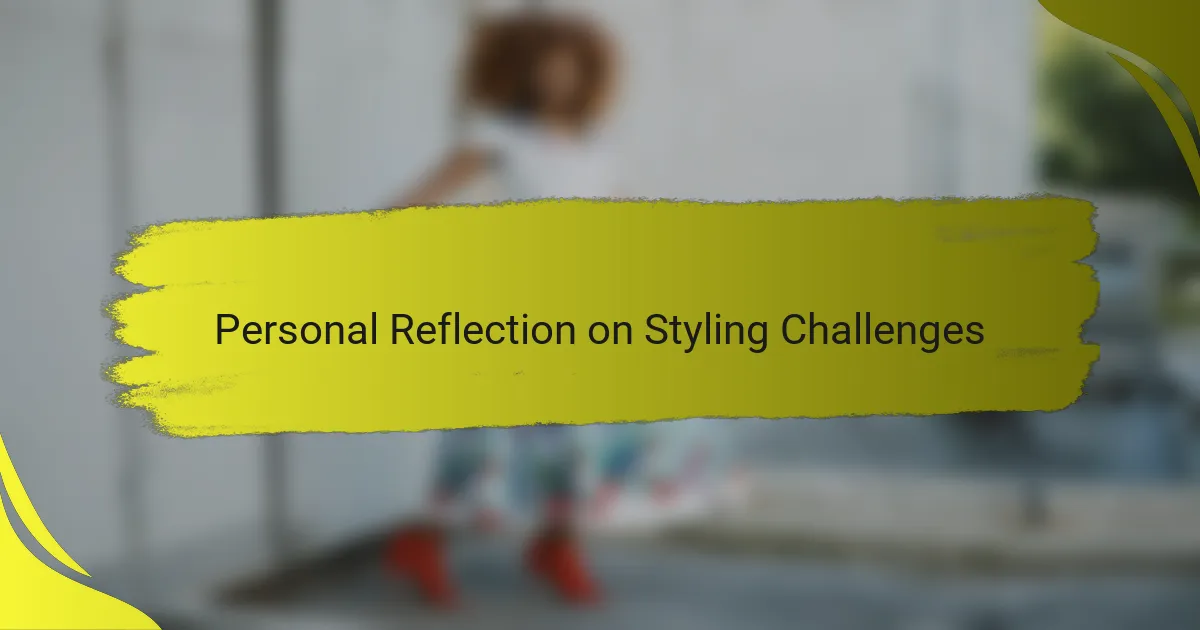
Personal Reflection on Styling Challenges
Styling experimental pieces like Florence Pugh’s looks hasn’t always been easy for me. I remember once trying to pair a wildly structured jacket with something casual, only to stand in front of the mirror doubting every angle. Have you ever felt that moment of uncertainty where what looks exciting in theory suddenly feels overwhelming in practice?
What I’ve learned through trial and error is that patience is key. Experimenting with these styles often means grappling with proportion, texture, and silhouette in ways that don’t come naturally at first. It’s like learning a new language—sometimes awkward, sometimes frustrating, but ultimately rewarding when the pieces start to speak to each other.
The vulnerability involved in styling bold, unconventional looks can’t be underestimated either. There’s this underlying fear of being misunderstood or judged, which I’ve definitely felt when stepping outside my comfort zone. But reflecting on those moments, I realize they’re opportunities—not setbacks—to grow confidence and develop a personal style that feels truly authentic. Isn’t that what fashion should be about at the end of the day?
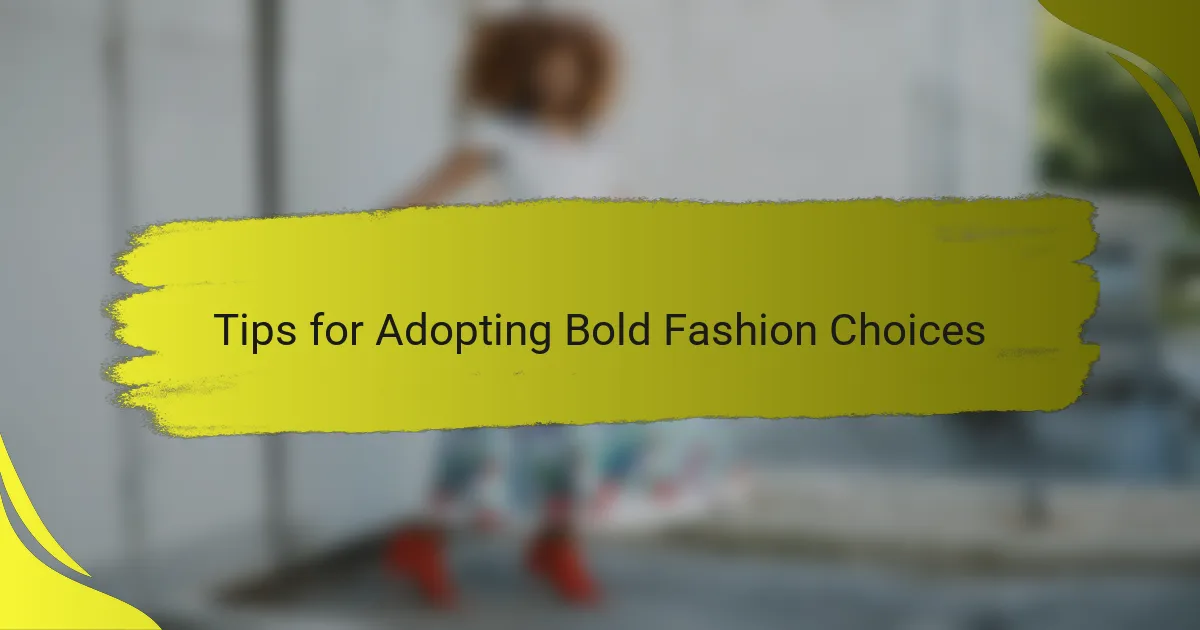
Tips for Adopting Bold Fashion Choices
Taking the plunge into bold fashion often starts with mindset. I’ve found that asking myself, “What’s the one daring detail I can add today?” helps break down the intimidation factor. Whether it’s a vibrant scarf or an eccentric pair of shoes, small choices build confidence over time and make boldness feel more natural than forced.
Another thing I’ve noticed is the power of comfort in carrying off an unconventional look. When I first tried out a dramatic asymmetrical jacket, I realized that if I didn’t physically feel good wearing it, the whole effect fell flat. Do you think it’s possible to truly shine if you’re constantly adjusting or feeling uneasy? For me, getting the fit and comfort right is half the battle won.
Lastly, don’t underestimate the joy of mixing old favorites with new, unexpected pieces. Sometimes, pairing a tried-and-true item with something experimental creates a harmony that feels exciting but still approachable. I love how this practice turned fashion from a source of anxiety into an adventurous playground where mistakes often lead to my most memorable outfits. Have you tried blending the familiar with the bold yet? It’s a game-changer.
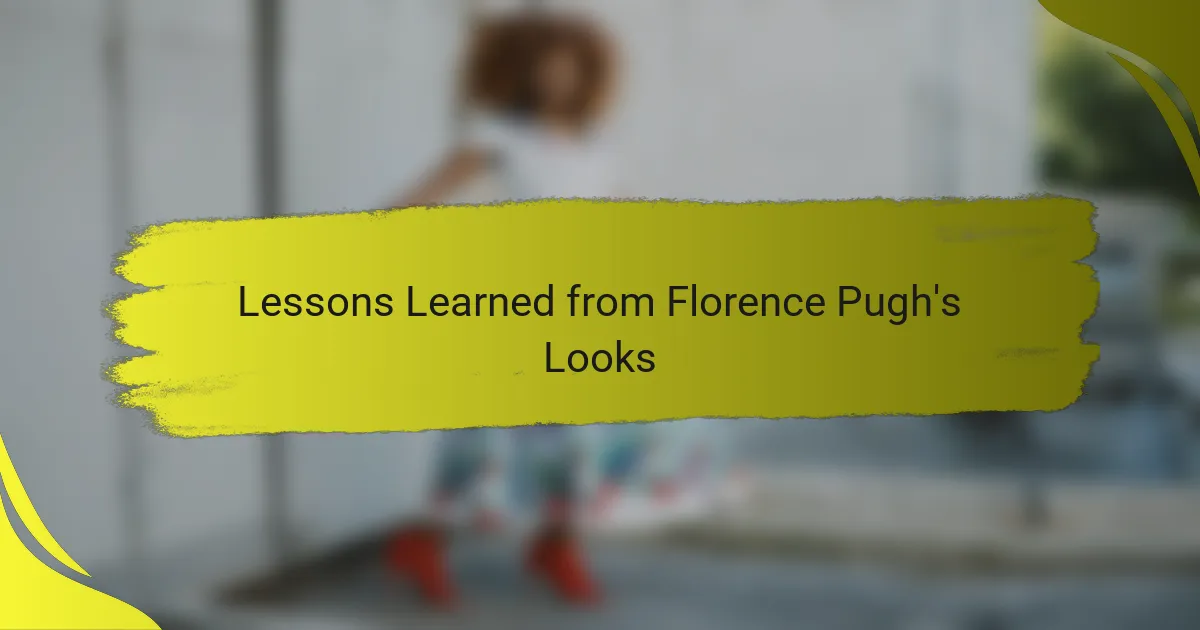
Lessons Learned from Florence Pugh’s Looks
One lesson Florence Pugh’s looks have taught me is that true style bravery comes from embracing imperfection. Watching her confidently rock asymmetrical cuts and unexpected fabric combos made me realize it’s okay if an outfit isn’t “perfect” by conventional standards. Have you noticed how letting go of the need to get everything exactly right actually makes fashion feel more playful and authentic?
Another insight I’ve gained is the importance of owning your choices wholeheartedly. Florence’s way of wearing bold pieces with a relaxed confidence shows that style isn’t just about the clothes themselves but how you carry them. I remember trying on a statement jacket and feeling immediately more powerful—not because it looked flawless, but because I believed in it. Doesn’t that shift in mindset make all the difference?
Finally, her looks remind me that fashion is a powerful form of storytelling. Each daring ensemble seems to express a mood or chapter of her life, which inspired me to view my wardrobe not just as clothes, but as personal narratives waiting to be told. How often do we consider what our outfits say about us beyond surface appeal? Florence pushed me to reflect on that deeper connection—and it’s been a game changer for my approach to style.
